Analysis of Airbnb Inc.'s Innovation and Future Pathways
VerifiedAdded on 2020/10/22
|13
|4282
|153
Report
AI Summary
This report provides a comprehensive analysis of Airbnb Inc.'s innovation strategies, focusing on its disruptive impact on the hospitality industry. It explores various innovation theories, including the Henderson-Clark model and disruptive innovation, to understand Airbnb's historical development and potential future pathways. The report examines how Airbnb has utilized incremental and radical innovation to enhance its services and maintain a competitive edge in the market. Furthermore, the report discusses Airbnb's future innovation plans, such as incorporating health and travel safety services, and how these innovations align with the company's growth objectives. Overall, the report offers valuable insights into Airbnb's innovation journey and its implications for the future of the hospitality sector.
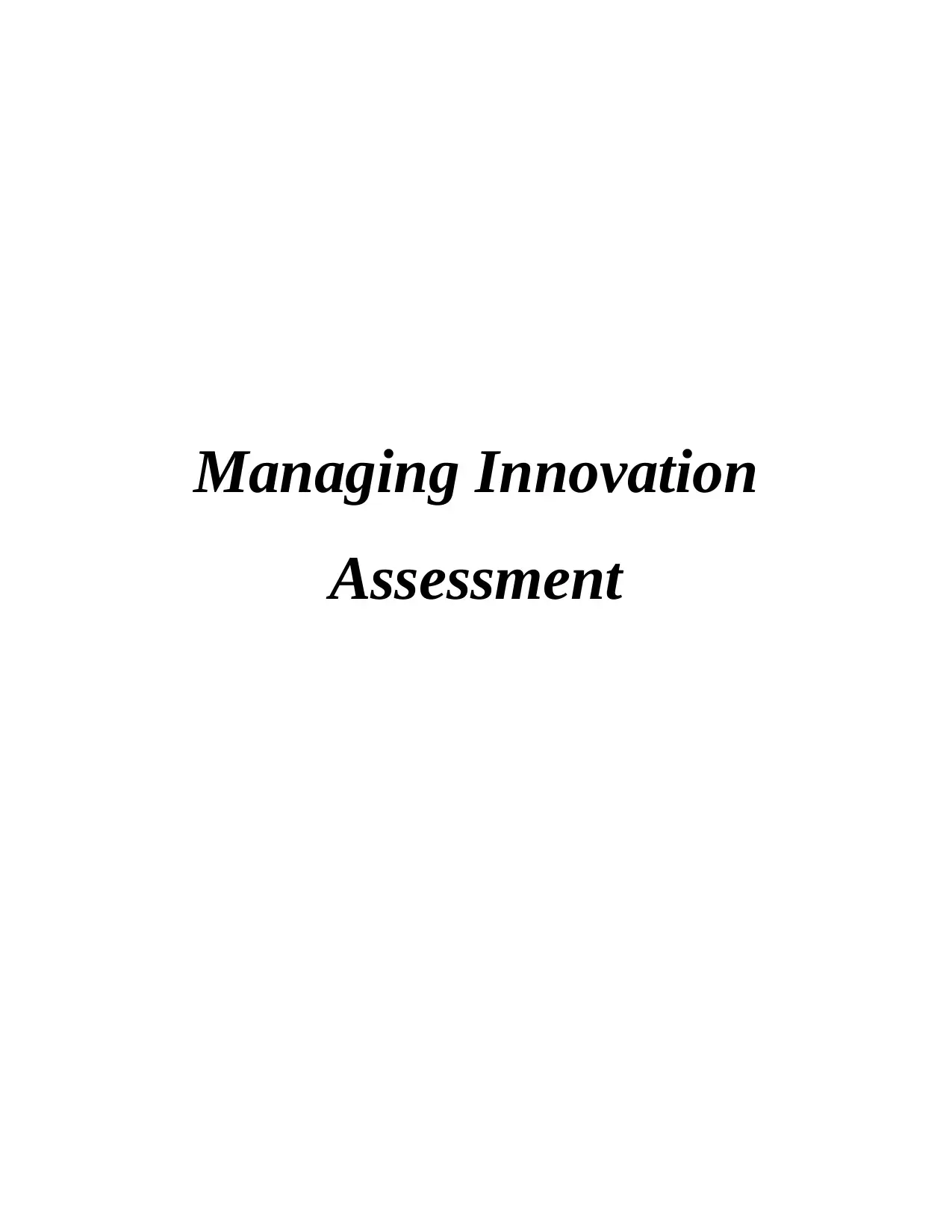
Managing Innovation
Assessment
Assessment
Paraphrase This Document
Need a fresh take? Get an instant paraphrase of this document with our AI Paraphraser
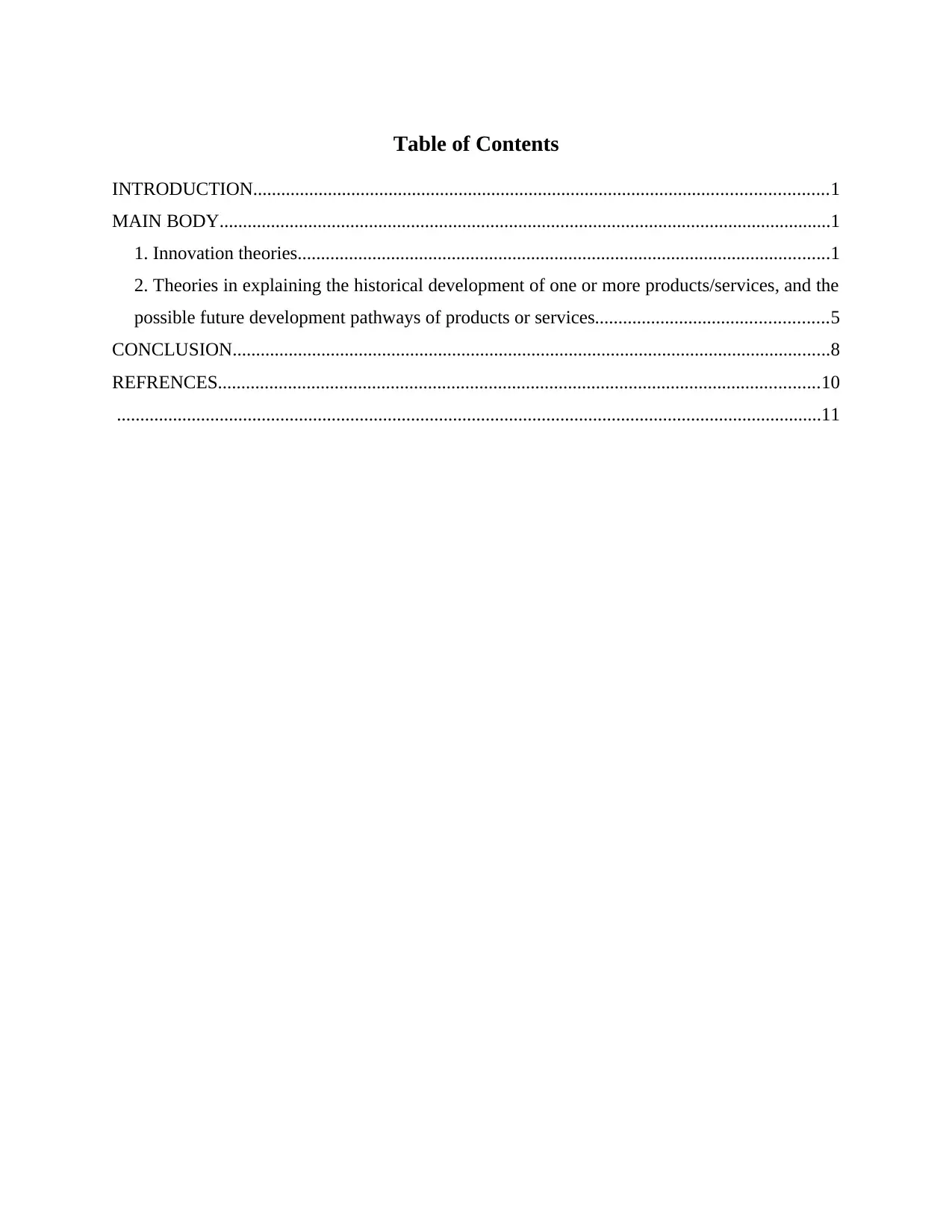
Table of Contents
INTRODUCTION...........................................................................................................................1
MAIN BODY...................................................................................................................................1
1. Innovation theories..................................................................................................................1
2. Theories in explaining the historical development of one or more products/services, and the
possible future development pathways of products or services..................................................5
CONCLUSION................................................................................................................................8
REFRENCES.................................................................................................................................10
.......................................................................................................................................................11
INTRODUCTION...........................................................................................................................1
MAIN BODY...................................................................................................................................1
1. Innovation theories..................................................................................................................1
2. Theories in explaining the historical development of one or more products/services, and the
possible future development pathways of products or services..................................................5
CONCLUSION................................................................................................................................8
REFRENCES.................................................................................................................................10
.......................................................................................................................................................11
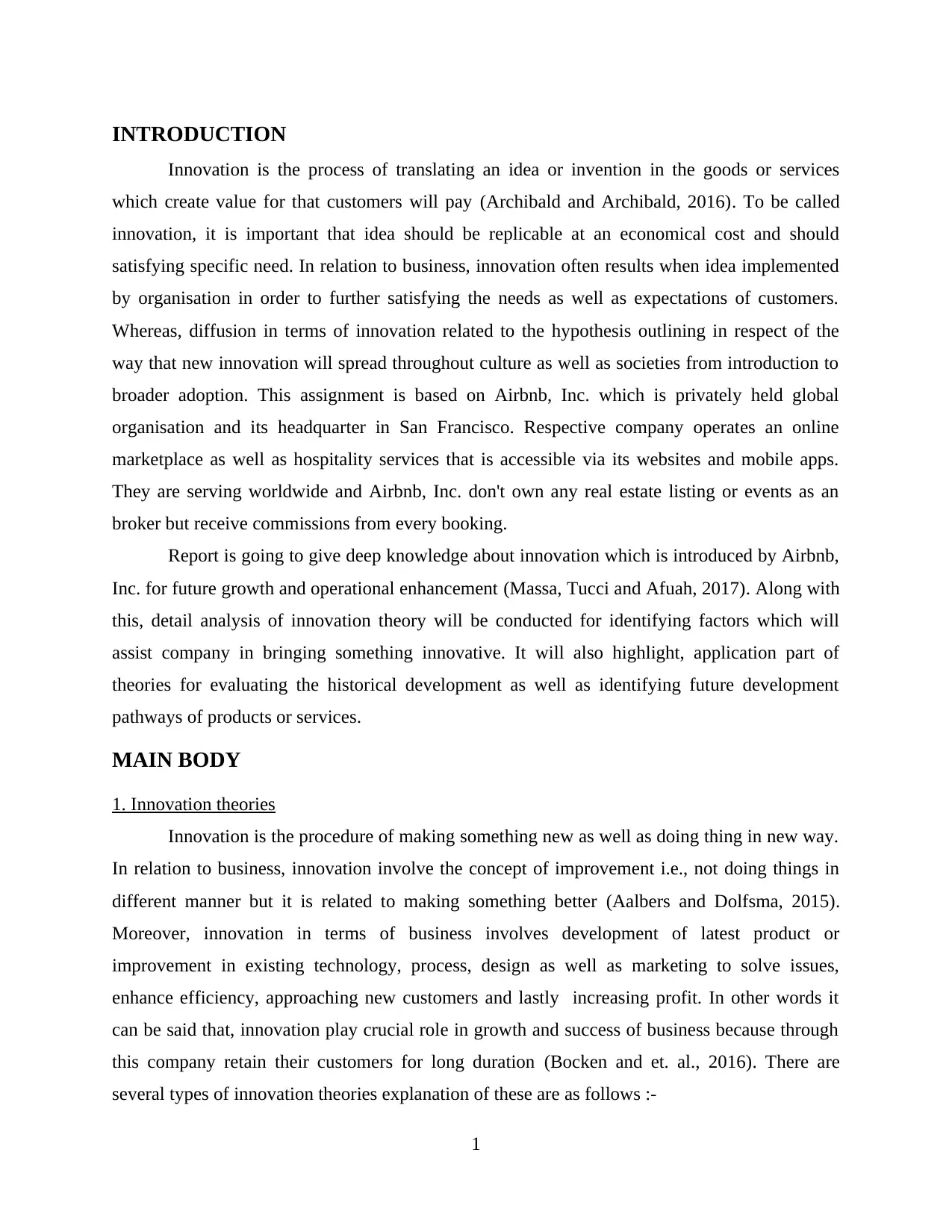
INTRODUCTION
Innovation is the process of translating an idea or invention in the goods or services
which create value for that customers will pay (Archibald and Archibald, 2016). To be called
innovation, it is important that idea should be replicable at an economical cost and should
satisfying specific need. In relation to business, innovation often results when idea implemented
by organisation in order to further satisfying the needs as well as expectations of customers.
Whereas, diffusion in terms of innovation related to the hypothesis outlining in respect of the
way that new innovation will spread throughout culture as well as societies from introduction to
broader adoption. This assignment is based on Airbnb, Inc. which is privately held global
organisation and its headquarter in San Francisco. Respective company operates an online
marketplace as well as hospitality services that is accessible via its websites and mobile apps.
They are serving worldwide and Airbnb, Inc. don't own any real estate listing or events as an
broker but receive commissions from every booking.
Report is going to give deep knowledge about innovation which is introduced by Airbnb,
Inc. for future growth and operational enhancement (Massa, Tucci and Afuah, 2017). Along with
this, detail analysis of innovation theory will be conducted for identifying factors which will
assist company in bringing something innovative. It will also highlight, application part of
theories for evaluating the historical development as well as identifying future development
pathways of products or services.
MAIN BODY
1. Innovation theories
Innovation is the procedure of making something new as well as doing thing in new way.
In relation to business, innovation involve the concept of improvement i.e., not doing things in
different manner but it is related to making something better (Aalbers and Dolfsma, 2015).
Moreover, innovation in terms of business involves development of latest product or
improvement in existing technology, process, design as well as marketing to solve issues,
enhance efficiency, approaching new customers and lastly increasing profit. In other words it
can be said that, innovation play crucial role in growth and success of business because through
this company retain their customers for long duration (Bocken and et. al., 2016). There are
several types of innovation theories explanation of these are as follows :-
1
Innovation is the process of translating an idea or invention in the goods or services
which create value for that customers will pay (Archibald and Archibald, 2016). To be called
innovation, it is important that idea should be replicable at an economical cost and should
satisfying specific need. In relation to business, innovation often results when idea implemented
by organisation in order to further satisfying the needs as well as expectations of customers.
Whereas, diffusion in terms of innovation related to the hypothesis outlining in respect of the
way that new innovation will spread throughout culture as well as societies from introduction to
broader adoption. This assignment is based on Airbnb, Inc. which is privately held global
organisation and its headquarter in San Francisco. Respective company operates an online
marketplace as well as hospitality services that is accessible via its websites and mobile apps.
They are serving worldwide and Airbnb, Inc. don't own any real estate listing or events as an
broker but receive commissions from every booking.
Report is going to give deep knowledge about innovation which is introduced by Airbnb,
Inc. for future growth and operational enhancement (Massa, Tucci and Afuah, 2017). Along with
this, detail analysis of innovation theory will be conducted for identifying factors which will
assist company in bringing something innovative. It will also highlight, application part of
theories for evaluating the historical development as well as identifying future development
pathways of products or services.
MAIN BODY
1. Innovation theories
Innovation is the procedure of making something new as well as doing thing in new way.
In relation to business, innovation involve the concept of improvement i.e., not doing things in
different manner but it is related to making something better (Aalbers and Dolfsma, 2015).
Moreover, innovation in terms of business involves development of latest product or
improvement in existing technology, process, design as well as marketing to solve issues,
enhance efficiency, approaching new customers and lastly increasing profit. In other words it
can be said that, innovation play crucial role in growth and success of business because through
this company retain their customers for long duration (Bocken and et. al., 2016). There are
several types of innovation theories explanation of these are as follows :-
1
⊘ This is a preview!⊘
Do you want full access?
Subscribe today to unlock all pages.

Trusted by 1+ million students worldwide
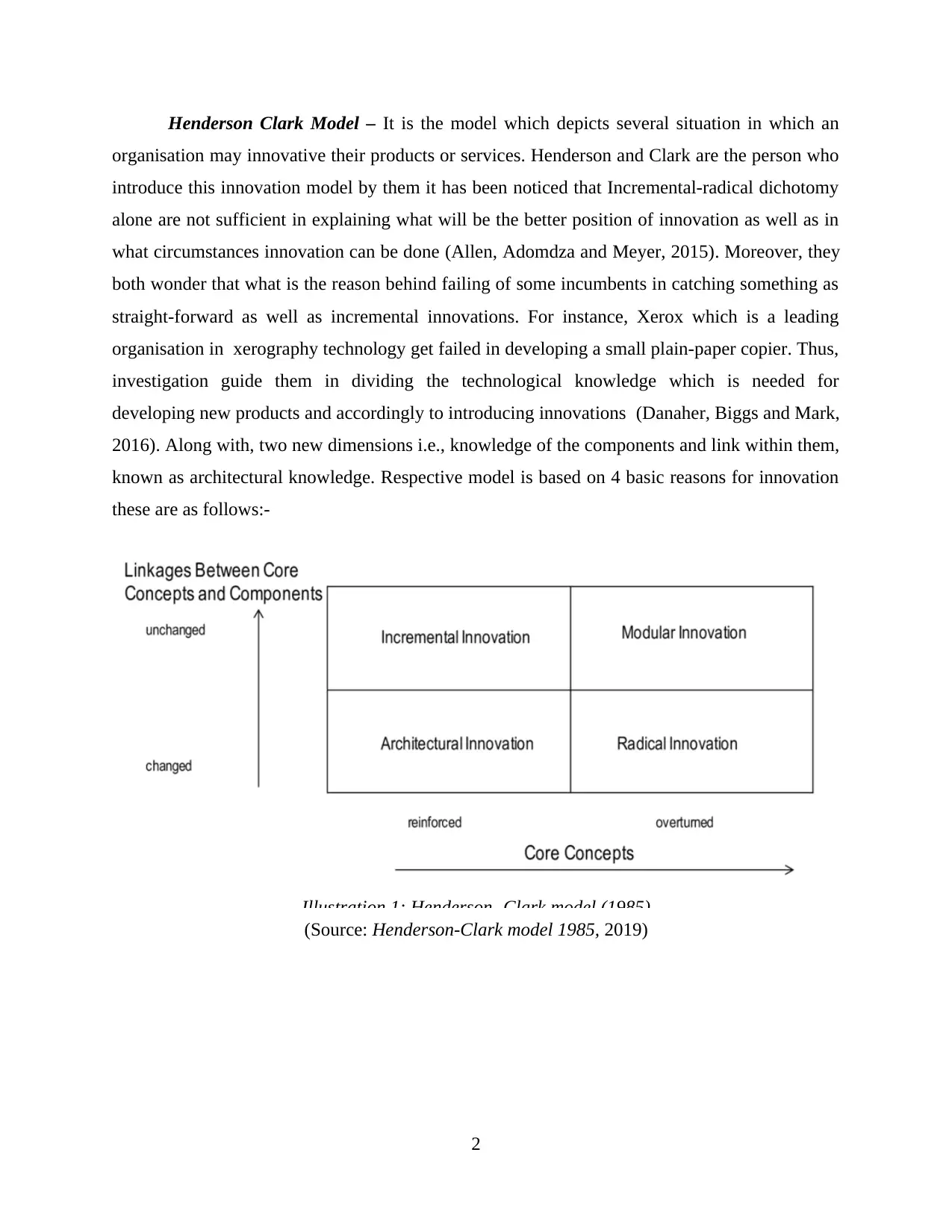
Henderson Clark Model – It is the model which depicts several situation in which an
organisation may innovative their products or services. Henderson and Clark are the person who
introduce this innovation model by them it has been noticed that Incremental-radical dichotomy
alone are not sufficient in explaining what will be the better position of innovation as well as in
what circumstances innovation can be done (Allen, Adomdza and Meyer, 2015). Moreover, they
both wonder that what is the reason behind failing of some incumbents in catching something as
straight-forward as well as incremental innovations. For instance, Xerox which is a leading
organisation in xerography technology get failed in developing a small plain-paper copier. Thus,
investigation guide them in dividing the technological knowledge which is needed for
developing new products and accordingly to introducing innovations (Danaher, Biggs and Mark,
2016). Along with, two new dimensions i.e., knowledge of the components and link within them,
known as architectural knowledge. Respective model is based on 4 basic reasons for innovation
these are as follows:-
(Source: Henderson-Clark model 1985, 2019)
2
Illustration 1: Henderson- Clark model (1985)
organisation may innovative their products or services. Henderson and Clark are the person who
introduce this innovation model by them it has been noticed that Incremental-radical dichotomy
alone are not sufficient in explaining what will be the better position of innovation as well as in
what circumstances innovation can be done (Allen, Adomdza and Meyer, 2015). Moreover, they
both wonder that what is the reason behind failing of some incumbents in catching something as
straight-forward as well as incremental innovations. For instance, Xerox which is a leading
organisation in xerography technology get failed in developing a small plain-paper copier. Thus,
investigation guide them in dividing the technological knowledge which is needed for
developing new products and accordingly to introducing innovations (Danaher, Biggs and Mark,
2016). Along with, two new dimensions i.e., knowledge of the components and link within them,
known as architectural knowledge. Respective model is based on 4 basic reasons for innovation
these are as follows:-
(Source: Henderson-Clark model 1985, 2019)
2
Illustration 1: Henderson- Clark model (1985)
Paraphrase This Document
Need a fresh take? Get an instant paraphrase of this document with our AI Paraphraser
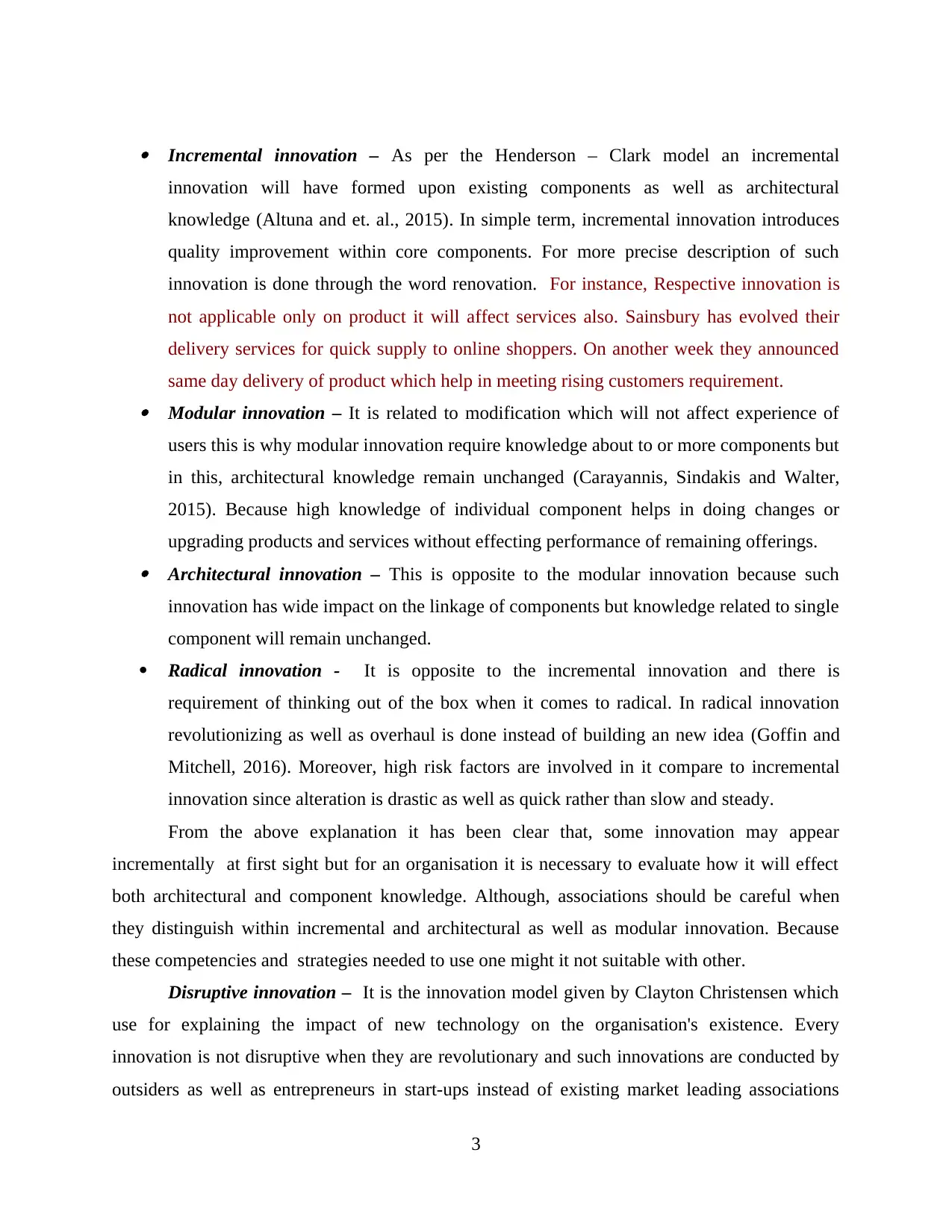
Incremental innovation – As per the Henderson – Clark model an incremental
innovation will have formed upon existing components as well as architectural
knowledge (Altuna and et. al., 2015). In simple term, incremental innovation introduces
quality improvement within core components. For more precise description of such
innovation is done through the word renovation. For instance, Respective innovation is
not applicable only on product it will affect services also. Sainsbury has evolved their
delivery services for quick supply to online shoppers. On another week they announced
same day delivery of product which help in meeting rising customers requirement. Modular innovation – It is related to modification which will not affect experience of
users this is why modular innovation require knowledge about to or more components but
in this, architectural knowledge remain unchanged (Carayannis, Sindakis and Walter,
2015). Because high knowledge of individual component helps in doing changes or
upgrading products and services without effecting performance of remaining offerings. Architectural innovation – This is opposite to the modular innovation because such
innovation has wide impact on the linkage of components but knowledge related to single
component will remain unchanged.
Radical innovation - It is opposite to the incremental innovation and there is
requirement of thinking out of the box when it comes to radical. In radical innovation
revolutionizing as well as overhaul is done instead of building an new idea (Goffin and
Mitchell, 2016). Moreover, high risk factors are involved in it compare to incremental
innovation since alteration is drastic as well as quick rather than slow and steady.
From the above explanation it has been clear that, some innovation may appear
incrementally at first sight but for an organisation it is necessary to evaluate how it will effect
both architectural and component knowledge. Although, associations should be careful when
they distinguish within incremental and architectural as well as modular innovation. Because
these competencies and strategies needed to use one might it not suitable with other.
Disruptive innovation – It is the innovation model given by Clayton Christensen which
use for explaining the impact of new technology on the organisation's existence. Every
innovation is not disruptive when they are revolutionary and such innovations are conducted by
outsiders as well as entrepreneurs in start-ups instead of existing market leading associations
3
innovation will have formed upon existing components as well as architectural
knowledge (Altuna and et. al., 2015). In simple term, incremental innovation introduces
quality improvement within core components. For more precise description of such
innovation is done through the word renovation. For instance, Respective innovation is
not applicable only on product it will affect services also. Sainsbury has evolved their
delivery services for quick supply to online shoppers. On another week they announced
same day delivery of product which help in meeting rising customers requirement. Modular innovation – It is related to modification which will not affect experience of
users this is why modular innovation require knowledge about to or more components but
in this, architectural knowledge remain unchanged (Carayannis, Sindakis and Walter,
2015). Because high knowledge of individual component helps in doing changes or
upgrading products and services without effecting performance of remaining offerings. Architectural innovation – This is opposite to the modular innovation because such
innovation has wide impact on the linkage of components but knowledge related to single
component will remain unchanged.
Radical innovation - It is opposite to the incremental innovation and there is
requirement of thinking out of the box when it comes to radical. In radical innovation
revolutionizing as well as overhaul is done instead of building an new idea (Goffin and
Mitchell, 2016). Moreover, high risk factors are involved in it compare to incremental
innovation since alteration is drastic as well as quick rather than slow and steady.
From the above explanation it has been clear that, some innovation may appear
incrementally at first sight but for an organisation it is necessary to evaluate how it will effect
both architectural and component knowledge. Although, associations should be careful when
they distinguish within incremental and architectural as well as modular innovation. Because
these competencies and strategies needed to use one might it not suitable with other.
Disruptive innovation – It is the innovation model given by Clayton Christensen which
use for explaining the impact of new technology on the organisation's existence. Every
innovation is not disruptive when they are revolutionary and such innovations are conducted by
outsiders as well as entrepreneurs in start-ups instead of existing market leading associations
3
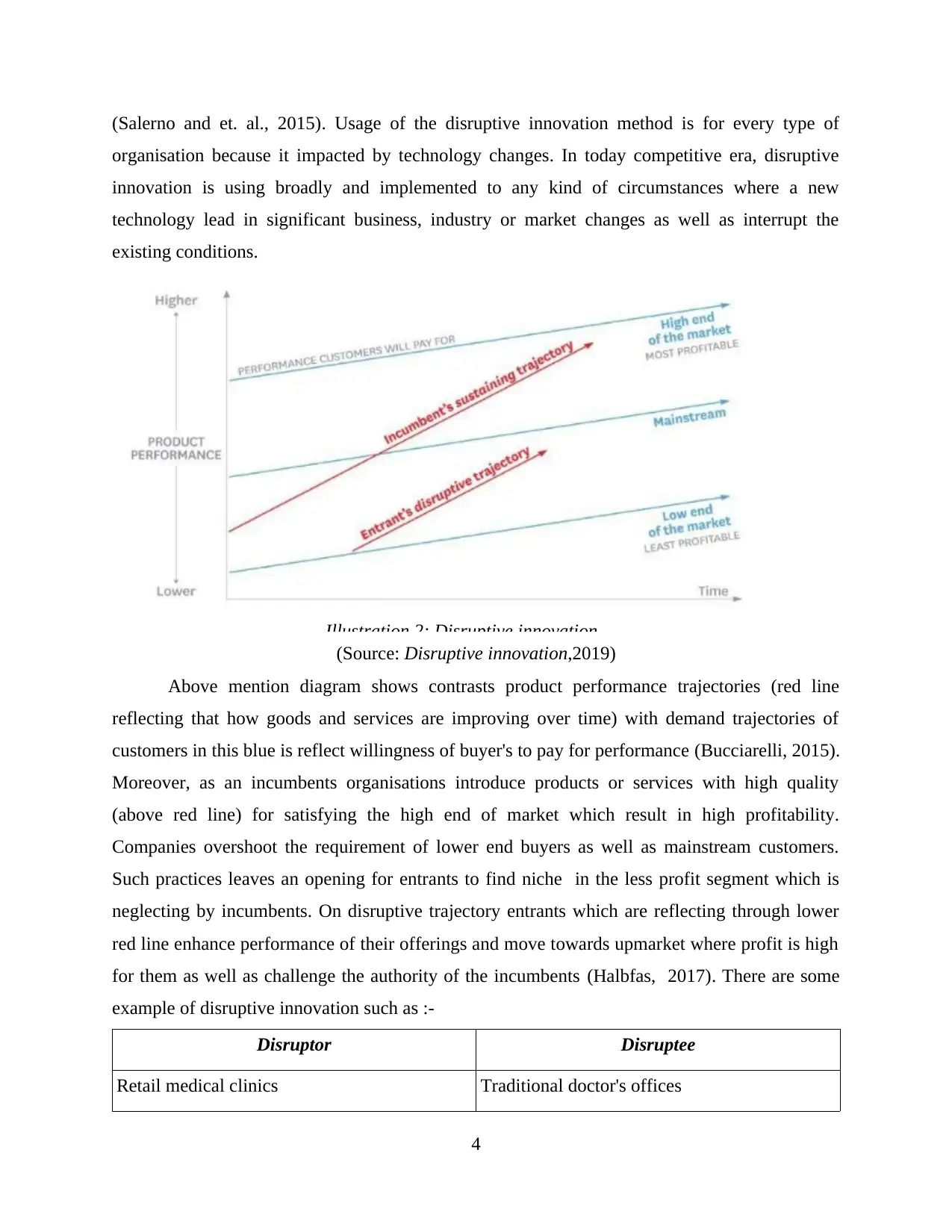
(Salerno and et. al., 2015). Usage of the disruptive innovation method is for every type of
organisation because it impacted by technology changes. In today competitive era, disruptive
innovation is using broadly and implemented to any kind of circumstances where a new
technology lead in significant business, industry or market changes as well as interrupt the
existing conditions.
(Source: Disruptive innovation,2019)
Above mention diagram shows contrasts product performance trajectories (red line
reflecting that how goods and services are improving over time) with demand trajectories of
customers in this blue is reflect willingness of buyer's to pay for performance (Bucciarelli, 2015).
Moreover, as an incumbents organisations introduce products or services with high quality
(above red line) for satisfying the high end of market which result in high profitability.
Companies overshoot the requirement of lower end buyers as well as mainstream customers.
Such practices leaves an opening for entrants to find niche in the less profit segment which is
neglecting by incumbents. On disruptive trajectory entrants which are reflecting through lower
red line enhance performance of their offerings and move towards upmarket where profit is high
for them as well as challenge the authority of the incumbents (Halbfas, 2017). There are some
example of disruptive innovation such as :-
Disruptor Disruptee
Retail medical clinics Traditional doctor's offices
4
Illustration 2: Disruptive innovation
organisation because it impacted by technology changes. In today competitive era, disruptive
innovation is using broadly and implemented to any kind of circumstances where a new
technology lead in significant business, industry or market changes as well as interrupt the
existing conditions.
(Source: Disruptive innovation,2019)
Above mention diagram shows contrasts product performance trajectories (red line
reflecting that how goods and services are improving over time) with demand trajectories of
customers in this blue is reflect willingness of buyer's to pay for performance (Bucciarelli, 2015).
Moreover, as an incumbents organisations introduce products or services with high quality
(above red line) for satisfying the high end of market which result in high profitability.
Companies overshoot the requirement of lower end buyers as well as mainstream customers.
Such practices leaves an opening for entrants to find niche in the less profit segment which is
neglecting by incumbents. On disruptive trajectory entrants which are reflecting through lower
red line enhance performance of their offerings and move towards upmarket where profit is high
for them as well as challenge the authority of the incumbents (Halbfas, 2017). There are some
example of disruptive innovation such as :-
Disruptor Disruptee
Retail medical clinics Traditional doctor's offices
4
Illustration 2: Disruptive innovation
⊘ This is a preview!⊘
Do you want full access?
Subscribe today to unlock all pages.

Trusted by 1+ million students worldwide

Personal computers Mainframe and mini computers
Mini mills Integrated steel mills
Cellular Phones Fixed line telephony
Discount retailers Full-service department stores
Community colleges Four-year colleges
Respective innovation is important because business leaders seeing that disruptive
improvement play important role in bringing benefits for customers as well as society, because
such innovators produces better products or services may be at lower price also. While at the
same time generating new values as well arouse additional enhancement beyond the early
repetition of their offerings (Hernandez-Munoz and et. al., 2015). As per the business thought
leaders, the reasons decision maker should have knowledge about disruptive innovation as well
as how it happen are two-fold. Awareness related to respective innovation will assist executives
in preparing their organisation to awaiting innovations that it could become competitors. It will
also give executives a better sense of whether, when and where they should support investments
into their own strategic development of expected disruptive innovations.
2. Theories in explaining the historical development of one or more products/services, and the
possible future development pathways of products or services.
Introduction to Airbnb Inc. - This organisation is of Lodging industry and founded in
2008, 10 years ago. Founder of Airbnb Inc. are Brian Chesky, Joe Gebbia and Nathan
Blecharczyk. They are serving at worldwide level but its headquarter is in San Francisco,
California (Tsai and Wu, 2015). Respective company operates an online marketplace as well as
hospitality services that is accessible through website and mobile apps of association. Member's
of Airbnb Inc. can use services for arranging or offering lodging, tourism experiences, primarily
homestays and so on. Apart from this, same organisation does not own any type of real estate
listing as well as not host events as an broker but they receives commissions from booking.
There are approx. 3100 staff members working in Airbnb Inc..
Historical discussion of innovations – Airbnb Inc. is the disruptive innovator is tourism
sector because they have internet based business model as well as it is uniquely appealing to
tourists (Kerl and Moehrle, 2017). By utilising reviews, users profiles, identity verification and
5
Mini mills Integrated steel mills
Cellular Phones Fixed line telephony
Discount retailers Full-service department stores
Community colleges Four-year colleges
Respective innovation is important because business leaders seeing that disruptive
improvement play important role in bringing benefits for customers as well as society, because
such innovators produces better products or services may be at lower price also. While at the
same time generating new values as well arouse additional enhancement beyond the early
repetition of their offerings (Hernandez-Munoz and et. al., 2015). As per the business thought
leaders, the reasons decision maker should have knowledge about disruptive innovation as well
as how it happen are two-fold. Awareness related to respective innovation will assist executives
in preparing their organisation to awaiting innovations that it could become competitors. It will
also give executives a better sense of whether, when and where they should support investments
into their own strategic development of expected disruptive innovations.
2. Theories in explaining the historical development of one or more products/services, and the
possible future development pathways of products or services.
Introduction to Airbnb Inc. - This organisation is of Lodging industry and founded in
2008, 10 years ago. Founder of Airbnb Inc. are Brian Chesky, Joe Gebbia and Nathan
Blecharczyk. They are serving at worldwide level but its headquarter is in San Francisco,
California (Tsai and Wu, 2015). Respective company operates an online marketplace as well as
hospitality services that is accessible through website and mobile apps of association. Member's
of Airbnb Inc. can use services for arranging or offering lodging, tourism experiences, primarily
homestays and so on. Apart from this, same organisation does not own any type of real estate
listing as well as not host events as an broker but they receives commissions from booking.
There are approx. 3100 staff members working in Airbnb Inc..
Historical discussion of innovations – Airbnb Inc. is the disruptive innovator is tourism
sector because they have internet based business model as well as it is uniquely appealing to
tourists (Kerl and Moehrle, 2017). By utilising reviews, users profiles, identity verification and
5
Paraphrase This Document
Need a fresh take? Get an instant paraphrase of this document with our AI Paraphraser
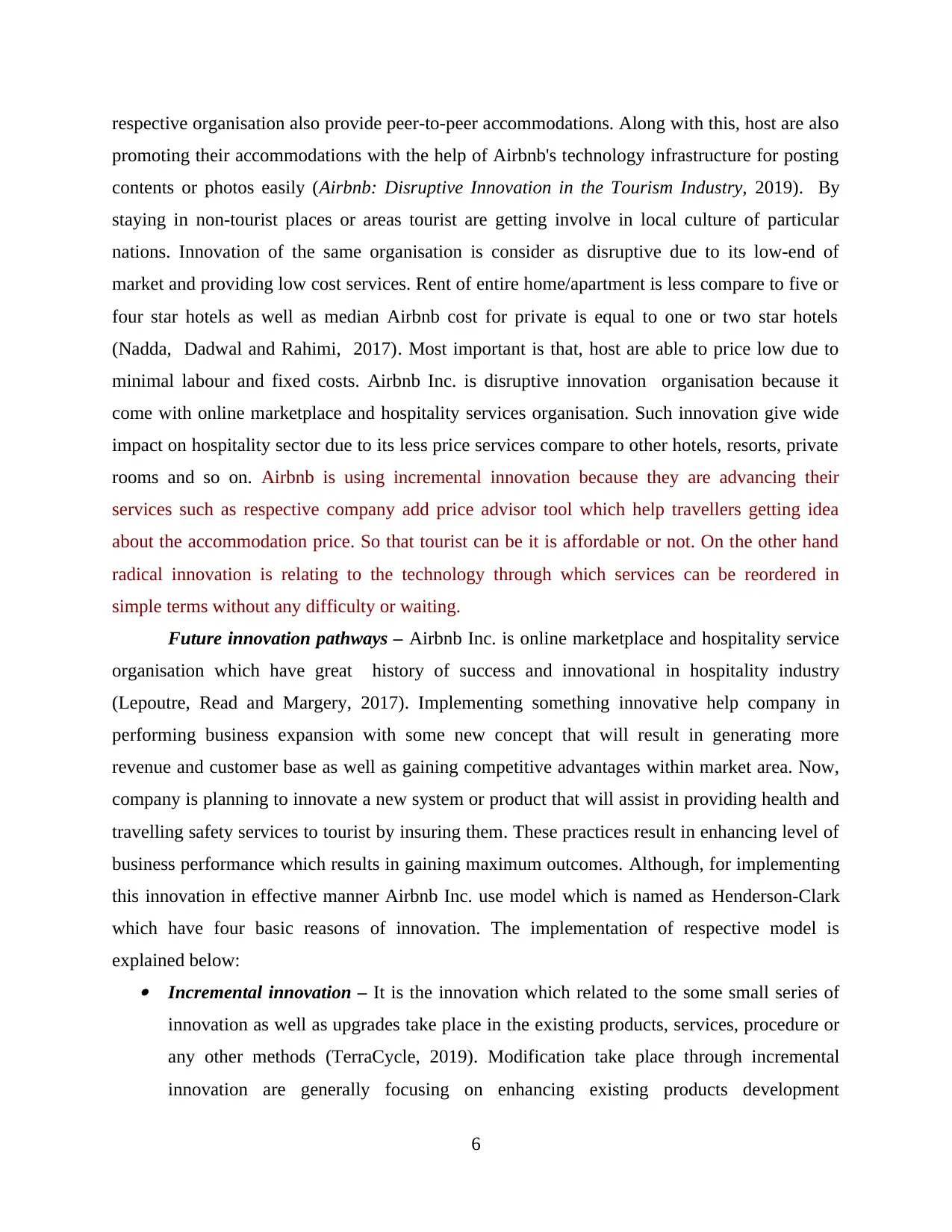
respective organisation also provide peer-to-peer accommodations. Along with this, host are also
promoting their accommodations with the help of Airbnb's technology infrastructure for posting
contents or photos easily (Airbnb: Disruptive Innovation in the Tourism Industry, 2019). By
staying in non-tourist places or areas tourist are getting involve in local culture of particular
nations. Innovation of the same organisation is consider as disruptive due to its low-end of
market and providing low cost services. Rent of entire home/apartment is less compare to five or
four star hotels as well as median Airbnb cost for private is equal to one or two star hotels
(Nadda, Dadwal and Rahimi, 2017). Most important is that, host are able to price low due to
minimal labour and fixed costs. Airbnb Inc. is disruptive innovation organisation because it
come with online marketplace and hospitality services organisation. Such innovation give wide
impact on hospitality sector due to its less price services compare to other hotels, resorts, private
rooms and so on. Airbnb is using incremental innovation because they are advancing their
services such as respective company add price advisor tool which help travellers getting idea
about the accommodation price. So that tourist can be it is affordable or not. On the other hand
radical innovation is relating to the technology through which services can be reordered in
simple terms without any difficulty or waiting.
Future innovation pathways – Airbnb Inc. is online marketplace and hospitality service
organisation which have great history of success and innovational in hospitality industry
(Lepoutre, Read and Margery, 2017). Implementing something innovative help company in
performing business expansion with some new concept that will result in generating more
revenue and customer base as well as gaining competitive advantages within market area. Now,
company is planning to innovate a new system or product that will assist in providing health and
travelling safety services to tourist by insuring them. These practices result in enhancing level of
business performance which results in gaining maximum outcomes. Although, for implementing
this innovation in effective manner Airbnb Inc. use model which is named as Henderson-Clark
which have four basic reasons of innovation. The implementation of respective model is
explained below: Incremental innovation – It is the innovation which related to the some small series of
innovation as well as upgrades take place in the existing products, services, procedure or
any other methods (TerraCycle, 2019). Modification take place through incremental
innovation are generally focusing on enhancing existing products development
6
promoting their accommodations with the help of Airbnb's technology infrastructure for posting
contents or photos easily (Airbnb: Disruptive Innovation in the Tourism Industry, 2019). By
staying in non-tourist places or areas tourist are getting involve in local culture of particular
nations. Innovation of the same organisation is consider as disruptive due to its low-end of
market and providing low cost services. Rent of entire home/apartment is less compare to five or
four star hotels as well as median Airbnb cost for private is equal to one or two star hotels
(Nadda, Dadwal and Rahimi, 2017). Most important is that, host are able to price low due to
minimal labour and fixed costs. Airbnb Inc. is disruptive innovation organisation because it
come with online marketplace and hospitality services organisation. Such innovation give wide
impact on hospitality sector due to its less price services compare to other hotels, resorts, private
rooms and so on. Airbnb is using incremental innovation because they are advancing their
services such as respective company add price advisor tool which help travellers getting idea
about the accommodation price. So that tourist can be it is affordable or not. On the other hand
radical innovation is relating to the technology through which services can be reordered in
simple terms without any difficulty or waiting.
Future innovation pathways – Airbnb Inc. is online marketplace and hospitality service
organisation which have great history of success and innovational in hospitality industry
(Lepoutre, Read and Margery, 2017). Implementing something innovative help company in
performing business expansion with some new concept that will result in generating more
revenue and customer base as well as gaining competitive advantages within market area. Now,
company is planning to innovate a new system or product that will assist in providing health and
travelling safety services to tourist by insuring them. These practices result in enhancing level of
business performance which results in gaining maximum outcomes. Although, for implementing
this innovation in effective manner Airbnb Inc. use model which is named as Henderson-Clark
which have four basic reasons of innovation. The implementation of respective model is
explained below: Incremental innovation – It is the innovation which related to the some small series of
innovation as well as upgrades take place in the existing products, services, procedure or
any other methods (TerraCycle, 2019). Modification take place through incremental
innovation are generally focusing on enhancing existing products development
6

efficiency, productivity as well as competitive differentiation. This is also use for
improving market position of products. In term of Airbnb Inc. Incremental innovation is
not suitable because they are bringing something new which is not related with their
existing working. Thus, they are not applying respective innovation in the process of
introducing insurance policies. Modular innovation – In respective innovation changes that will not give impact on
experience of users take place. This is the reason that, in modular innovation knowledge
about two or more components are needed (Wallace, 2015). Because depth knowledge
related to individual component assists in applying modifications or upgrading products
and services without effecting performance of remaining offerings. Thus, Airbnb Inc. can
use modular innovation for brining insurance services related to health and travelling for
tourist which they can avail within 1 year. So respective organisation have to keep in
mind miss-happening which can happen while travelling. While bringing insurance
services in the market area along with its policies or terms and condition of availing. Architectural innovation – This is type of innovation is alternate to the modular because
such kind of innovation have wide effect on several components linked with each other.
But in this case knowledge related to single components will not change (Shaw and
Allen, 2018). In case of Airbnb Inc. they can launch insurance innovation with the help of
respective model. Because respective organisation is providing online hospitality
services in which insurance help in attracting tourist as well as play important role in
their safety. Radical innovation - In this type of innovation there is requirement of thinking out of
the box and in online hospitality services providing insurance benefits is something
different. Thus, radical innovation is best for future implementing health and travelling
insurance services to tourist.
Business model discussion - Business model is the plan of company which shows that
how it will generate revenue and profits. Along with the, purpose, goals as well as ongoing plan
for accomplishing them (Lin, Wei and Zhu, 2015). In simple term it can be said that business
model describe that how an organisation will fulfil their purpose. Airbnb Inc. is following
business model that will assist them in performing their operations in better manner and gaining
success in the market area. Along with this, it is important for respective organisation to design
7
improving market position of products. In term of Airbnb Inc. Incremental innovation is
not suitable because they are bringing something new which is not related with their
existing working. Thus, they are not applying respective innovation in the process of
introducing insurance policies. Modular innovation – In respective innovation changes that will not give impact on
experience of users take place. This is the reason that, in modular innovation knowledge
about two or more components are needed (Wallace, 2015). Because depth knowledge
related to individual component assists in applying modifications or upgrading products
and services without effecting performance of remaining offerings. Thus, Airbnb Inc. can
use modular innovation for brining insurance services related to health and travelling for
tourist which they can avail within 1 year. So respective organisation have to keep in
mind miss-happening which can happen while travelling. While bringing insurance
services in the market area along with its policies or terms and condition of availing. Architectural innovation – This is type of innovation is alternate to the modular because
such kind of innovation have wide effect on several components linked with each other.
But in this case knowledge related to single components will not change (Shaw and
Allen, 2018). In case of Airbnb Inc. they can launch insurance innovation with the help of
respective model. Because respective organisation is providing online hospitality
services in which insurance help in attracting tourist as well as play important role in
their safety. Radical innovation - In this type of innovation there is requirement of thinking out of
the box and in online hospitality services providing insurance benefits is something
different. Thus, radical innovation is best for future implementing health and travelling
insurance services to tourist.
Business model discussion - Business model is the plan of company which shows that
how it will generate revenue and profits. Along with the, purpose, goals as well as ongoing plan
for accomplishing them (Lin, Wei and Zhu, 2015). In simple term it can be said that business
model describe that how an organisation will fulfil their purpose. Airbnb Inc. is following
business model that will assist them in performing their operations in better manner and gaining
success in the market area. Along with this, it is important for respective organisation to design
7
⊘ This is a preview!⊘
Do you want full access?
Subscribe today to unlock all pages.

Trusted by 1+ million students worldwide

business model in different manner so it will be distinct from other competitors.s Below mention
factors are describing business model which is use for providing insurance services to tourist :- Ideation – it is totally depends upon the providing health and travelling insurance
facilities to tourist for the safety and enhancing customer base. Because while travelling
there is chance of miss-happening which can get secure with the assistance of insurance
facility providing by Airbnb. Concept design - After formation of idea, second step is related to concept designing of
insurance services will be design for applying the plan into action which involve forming
up a plan for the protecting tourist in terms of health and safety. Prototyping - After designing concept technical team will work on it and form up a
prototype model for identifying how insurance services will work after look introducing.
For identifying that it will work in proper manner as per the thinking or not. Experimenting - The prototype of health ad travelling insurance will move towards detail
analysis with the motive of determining modification required within the innovation so
that proper rectification can be done within insurance policies so it will work in
appropriate manner for achieving goals of company (Hira and Reilly, 2017). Detail Design - After identifying all the problems and mistake prototype have, Airbnb
Inc. will work on it so they can overcome with the errors and design final policies of
insurance. From this design, insurance policies will be formed by keeping in mind all the
mistakes occur previously in design.
Implementing – Once the insurance policies has been designed in proper manner these
are implemented by the Airbnb Inc. on different tourist by providing them security
related to health and safety (Sung, 2015).
Apart from this, before bringing innovation Airbnb is using aggregator business model as
well as it doesn't have linear business model like traditional hotel chains Hilton, Marriott and so
on. Moreover, traditional hotels invest more amount in building as well as maintaining their
properties. But key resources of Airbnb is people which don't require any maintenance (Airbnb
Business Model, 2018). Thus, it enables it to grow incredibly fast at zero marginal cost.
CONCLUSION
From the above discussion it has been summarised that innovation play important role in
the growth as well as success of an organisation because it assist them in gaining competitive
8
factors are describing business model which is use for providing insurance services to tourist :- Ideation – it is totally depends upon the providing health and travelling insurance
facilities to tourist for the safety and enhancing customer base. Because while travelling
there is chance of miss-happening which can get secure with the assistance of insurance
facility providing by Airbnb. Concept design - After formation of idea, second step is related to concept designing of
insurance services will be design for applying the plan into action which involve forming
up a plan for the protecting tourist in terms of health and safety. Prototyping - After designing concept technical team will work on it and form up a
prototype model for identifying how insurance services will work after look introducing.
For identifying that it will work in proper manner as per the thinking or not. Experimenting - The prototype of health ad travelling insurance will move towards detail
analysis with the motive of determining modification required within the innovation so
that proper rectification can be done within insurance policies so it will work in
appropriate manner for achieving goals of company (Hira and Reilly, 2017). Detail Design - After identifying all the problems and mistake prototype have, Airbnb
Inc. will work on it so they can overcome with the errors and design final policies of
insurance. From this design, insurance policies will be formed by keeping in mind all the
mistakes occur previously in design.
Implementing – Once the insurance policies has been designed in proper manner these
are implemented by the Airbnb Inc. on different tourist by providing them security
related to health and safety (Sung, 2015).
Apart from this, before bringing innovation Airbnb is using aggregator business model as
well as it doesn't have linear business model like traditional hotel chains Hilton, Marriott and so
on. Moreover, traditional hotels invest more amount in building as well as maintaining their
properties. But key resources of Airbnb is people which don't require any maintenance (Airbnb
Business Model, 2018). Thus, it enables it to grow incredibly fast at zero marginal cost.
CONCLUSION
From the above discussion it has been summarised that innovation play important role in
the growth as well as success of an organisation because it assist them in gaining competitive
8
Paraphrase This Document
Need a fresh take? Get an instant paraphrase of this document with our AI Paraphraser

advantages as well as customer base within dynamic environment. Henderson-Clark innovation
model is the best pathway which help organisation in implementing innovation in effectual
manner. Respective model also link human resource department with innovation planning
because it will support in successful applying as well as execution of innovation within market
area. Airbnb Inc. have great history of innovation within hospitality industry by providing low
cost rent services to tourist. Now it has been expected that organisation will bring something
innovative for simplifying their operations and achieving customer base. Thus, it has been found
that Airbnb Inc. is introducing health and travelling insurance services to tourist which can be
avail within 1 year. The reason behind this innovation is to provide health as well as travelling
safety to people who belong from other nations and travelling in other. This innovation has been
drawn from historic innovational analysis with the motive of gaining better outcomes by
applying respective plan with the assistance of business model follow by company which gives
surety of success.
APENDIX In March 2009 – In the respective year name of the organisation was shortened to
Airbnb.com along with this, content in site are also expanded such as air beds, shared to
several properties involving homes as well as apartments, castles, private rooms, tree
houses, igloos, manors, private islands and many other properties. On 9th May 2011 – Their is an feature called Social Connections added by Airbnb Inc.
which help user to see that they have common friends with hosts or guests through
Facebook. In 2015 – On 29th April Airbnb Inc. launched an official iPad app. Along with this, on 4th
June an pricing recommendation tool is added by respective organisation knowns as price
tips and offering suggestions on suitable prices for people renting apartments (Meng and
Brown, 2018).
On 3rd September 2015 – The same organisation releases an app for Apple Watch, its
main focus is on maintain proper communication within guests and hosts.
9
model is the best pathway which help organisation in implementing innovation in effectual
manner. Respective model also link human resource department with innovation planning
because it will support in successful applying as well as execution of innovation within market
area. Airbnb Inc. have great history of innovation within hospitality industry by providing low
cost rent services to tourist. Now it has been expected that organisation will bring something
innovative for simplifying their operations and achieving customer base. Thus, it has been found
that Airbnb Inc. is introducing health and travelling insurance services to tourist which can be
avail within 1 year. The reason behind this innovation is to provide health as well as travelling
safety to people who belong from other nations and travelling in other. This innovation has been
drawn from historic innovational analysis with the motive of gaining better outcomes by
applying respective plan with the assistance of business model follow by company which gives
surety of success.
APENDIX In March 2009 – In the respective year name of the organisation was shortened to
Airbnb.com along with this, content in site are also expanded such as air beds, shared to
several properties involving homes as well as apartments, castles, private rooms, tree
houses, igloos, manors, private islands and many other properties. On 9th May 2011 – Their is an feature called Social Connections added by Airbnb Inc.
which help user to see that they have common friends with hosts or guests through
Facebook. In 2015 – On 29th April Airbnb Inc. launched an official iPad app. Along with this, on 4th
June an pricing recommendation tool is added by respective organisation knowns as price
tips and offering suggestions on suitable prices for people renting apartments (Meng and
Brown, 2018).
On 3rd September 2015 – The same organisation releases an app for Apple Watch, its
main focus is on maintain proper communication within guests and hosts.
9
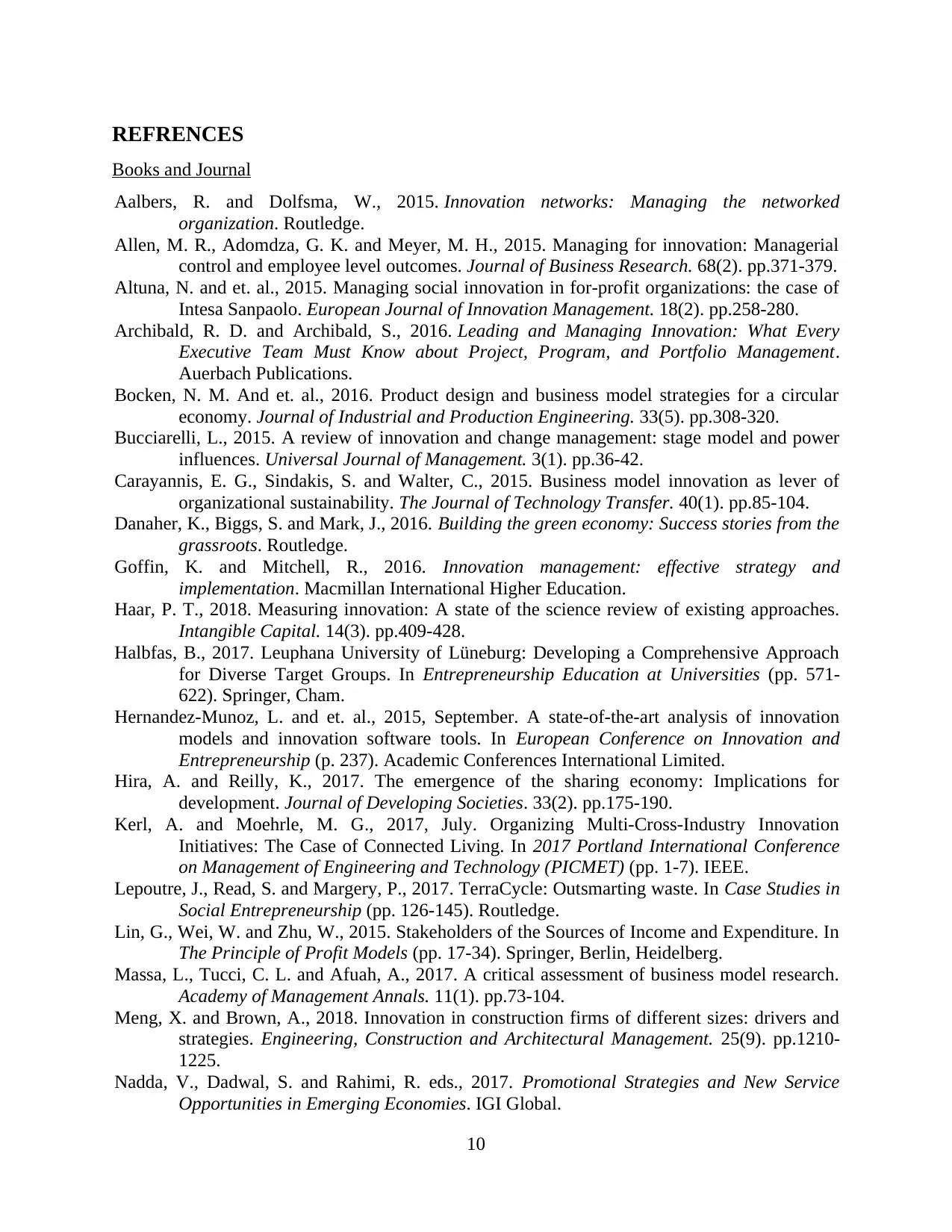
REFRENCES
Books and Journal
Aalbers, R. and Dolfsma, W., 2015. Innovation networks: Managing the networked
organization. Routledge.
Allen, M. R., Adomdza, G. K. and Meyer, M. H., 2015. Managing for innovation: Managerial
control and employee level outcomes. Journal of Business Research. 68(2). pp.371-379.
Altuna, N. and et. al., 2015. Managing social innovation in for-profit organizations: the case of
Intesa Sanpaolo. European Journal of Innovation Management. 18(2). pp.258-280.
Archibald, R. D. and Archibald, S., 2016. Leading and Managing Innovation: What Every
Executive Team Must Know about Project, Program, and Portfolio Management.
Auerbach Publications.
Bocken, N. M. And et. al., 2016. Product design and business model strategies for a circular
economy. Journal of Industrial and Production Engineering. 33(5). pp.308-320.
Bucciarelli, L., 2015. A review of innovation and change management: stage model and power
influences. Universal Journal of Management. 3(1). pp.36-42.
Carayannis, E. G., Sindakis, S. and Walter, C., 2015. Business model innovation as lever of
organizational sustainability. The Journal of Technology Transfer. 40(1). pp.85-104.
Danaher, K., Biggs, S. and Mark, J., 2016. Building the green economy: Success stories from the
grassroots. Routledge.
Goffin, K. and Mitchell, R., 2016. Innovation management: effective strategy and
implementation. Macmillan International Higher Education.
Haar, P. T., 2018. Measuring innovation: A state of the science review of existing approaches.
Intangible Capital. 14(3). pp.409-428.
Halbfas, B., 2017. Leuphana University of Lüneburg: Developing a Comprehensive Approach
for Diverse Target Groups. In Entrepreneurship Education at Universities (pp. 571-
622). Springer, Cham.
Hernandez-Munoz, L. and et. al., 2015, September. A state-of-the-art analysis of innovation
models and innovation software tools. In European Conference on Innovation and
Entrepreneurship (p. 237). Academic Conferences International Limited.
Hira, A. and Reilly, K., 2017. The emergence of the sharing economy: Implications for
development. Journal of Developing Societies. 33(2). pp.175-190.
Kerl, A. and Moehrle, M. G., 2017, July. Organizing Multi-Cross-Industry Innovation
Initiatives: The Case of Connected Living. In 2017 Portland International Conference
on Management of Engineering and Technology (PICMET) (pp. 1-7). IEEE.
Lepoutre, J., Read, S. and Margery, P., 2017. TerraCycle: Outsmarting waste. In Case Studies in
Social Entrepreneurship (pp. 126-145). Routledge.
Lin, G., Wei, W. and Zhu, W., 2015. Stakeholders of the Sources of Income and Expenditure. In
The Principle of Profit Models (pp. 17-34). Springer, Berlin, Heidelberg.
Massa, L., Tucci, C. L. and Afuah, A., 2017. A critical assessment of business model research.
Academy of Management Annals. 11(1). pp.73-104.
Meng, X. and Brown, A., 2018. Innovation in construction firms of different sizes: drivers and
strategies. Engineering, Construction and Architectural Management. 25(9). pp.1210-
1225.
Nadda, V., Dadwal, S. and Rahimi, R. eds., 2017. Promotional Strategies and New Service
Opportunities in Emerging Economies. IGI Global.
10
Books and Journal
Aalbers, R. and Dolfsma, W., 2015. Innovation networks: Managing the networked
organization. Routledge.
Allen, M. R., Adomdza, G. K. and Meyer, M. H., 2015. Managing for innovation: Managerial
control and employee level outcomes. Journal of Business Research. 68(2). pp.371-379.
Altuna, N. and et. al., 2015. Managing social innovation in for-profit organizations: the case of
Intesa Sanpaolo. European Journal of Innovation Management. 18(2). pp.258-280.
Archibald, R. D. and Archibald, S., 2016. Leading and Managing Innovation: What Every
Executive Team Must Know about Project, Program, and Portfolio Management.
Auerbach Publications.
Bocken, N. M. And et. al., 2016. Product design and business model strategies for a circular
economy. Journal of Industrial and Production Engineering. 33(5). pp.308-320.
Bucciarelli, L., 2015. A review of innovation and change management: stage model and power
influences. Universal Journal of Management. 3(1). pp.36-42.
Carayannis, E. G., Sindakis, S. and Walter, C., 2015. Business model innovation as lever of
organizational sustainability. The Journal of Technology Transfer. 40(1). pp.85-104.
Danaher, K., Biggs, S. and Mark, J., 2016. Building the green economy: Success stories from the
grassroots. Routledge.
Goffin, K. and Mitchell, R., 2016. Innovation management: effective strategy and
implementation. Macmillan International Higher Education.
Haar, P. T., 2018. Measuring innovation: A state of the science review of existing approaches.
Intangible Capital. 14(3). pp.409-428.
Halbfas, B., 2017. Leuphana University of Lüneburg: Developing a Comprehensive Approach
for Diverse Target Groups. In Entrepreneurship Education at Universities (pp. 571-
622). Springer, Cham.
Hernandez-Munoz, L. and et. al., 2015, September. A state-of-the-art analysis of innovation
models and innovation software tools. In European Conference on Innovation and
Entrepreneurship (p. 237). Academic Conferences International Limited.
Hira, A. and Reilly, K., 2017. The emergence of the sharing economy: Implications for
development. Journal of Developing Societies. 33(2). pp.175-190.
Kerl, A. and Moehrle, M. G., 2017, July. Organizing Multi-Cross-Industry Innovation
Initiatives: The Case of Connected Living. In 2017 Portland International Conference
on Management of Engineering and Technology (PICMET) (pp. 1-7). IEEE.
Lepoutre, J., Read, S. and Margery, P., 2017. TerraCycle: Outsmarting waste. In Case Studies in
Social Entrepreneurship (pp. 126-145). Routledge.
Lin, G., Wei, W. and Zhu, W., 2015. Stakeholders of the Sources of Income and Expenditure. In
The Principle of Profit Models (pp. 17-34). Springer, Berlin, Heidelberg.
Massa, L., Tucci, C. L. and Afuah, A., 2017. A critical assessment of business model research.
Academy of Management Annals. 11(1). pp.73-104.
Meng, X. and Brown, A., 2018. Innovation in construction firms of different sizes: drivers and
strategies. Engineering, Construction and Architectural Management. 25(9). pp.1210-
1225.
Nadda, V., Dadwal, S. and Rahimi, R. eds., 2017. Promotional Strategies and New Service
Opportunities in Emerging Economies. IGI Global.
10
⊘ This is a preview!⊘
Do you want full access?
Subscribe today to unlock all pages.

Trusted by 1+ million students worldwide
1 out of 13
Related Documents
Your All-in-One AI-Powered Toolkit for Academic Success.
+13062052269
info@desklib.com
Available 24*7 on WhatsApp / Email
![[object Object]](/_next/static/media/star-bottom.7253800d.svg)
Unlock your academic potential
Copyright © 2020–2025 A2Z Services. All Rights Reserved. Developed and managed by ZUCOL.





